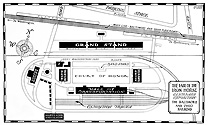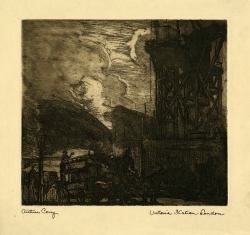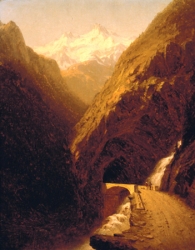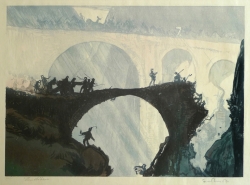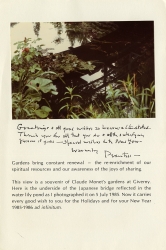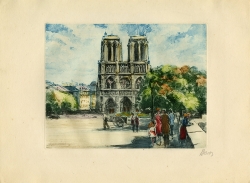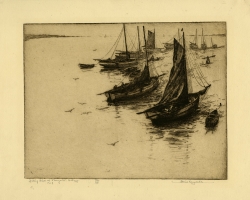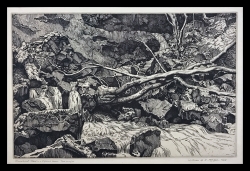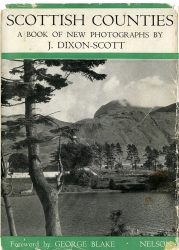Introduction
The Booth Family Center for Special Collections celebrates the fall 2020 semester with an exhibition for the armchair traveler. The selections represent the golden age of travel between the two World Wars and into the 1950s, when travel by land was primarily via rail and locomotives had transitioned from steam to electric power. During this period a number of independent rail lines were amalgamated into fewer, major railway companies that commissioned vibrant, colorful posters advertising the allure of glamorous destinations. With its title drawn from one of the posters, The Train Takes You includes posters previously displayed in a 2010 Library exhibition. Following our renovation and expansion in 2015, the current exhibition is augmented by additional works depicting related views and subjects. With foreign travel currently restricted, now is the perfect time to revisit these majestic locales and begin planning the long-awaited post-pandemic vacation.
The nineteen posters featured online and currently on display in the Library represent the U.K., France, the United States, Australia, South Africa and Switzerland. Complementary works include an important Alpine painting by American landscapist Sanford Gifford, and a recently acquired prize-winning color woodcut by British artist John Platt, along with varied prints and ephemera.
While most of the advertising posters we see today are photographically designed, their predecessors relied on the eye of the artist to embellish upon or artfully extract from the beauty of nature. Whether targeting a domestic or an international clientele, these vivid lithographic posters employ minimal use of text, relying on idealized illustration, sometimes with a catchy phrase, to encourage viewers to book their next exciting trip abroad.
These rare and picturesque travel posters are drawn from the extensive collection of railroad memorabilia assembled by alumnus Jeremiah J. O’Connor and donated to the library by his sister, Margaret M. O’Connor. After receiving his undergraduate and law degrees at Georgetown, O'Connor served in World War II and had a distinguished career in the foreign service. He served as first secretary of the American consulate in Vienna and as consul general in the State Department. When he died at the age of 50 in 1964, O'Connor was working in the Department's inspector corps.
Early Steam Engines
The Best Friend of Charleston
mixed media
circa 1930
From the collection of Jeremiah J. O’Connor
Gift of Margaret M. O’Connor
This hand-crafted model is a replica of the “Best Friend of Charleston,” the first American-made steam-powered locomotive for scheduled passenger service on a railroad. The Best Friend was designed as a four-wheel engine with a boiler shaped like a porter bottle in the center. It was put into service in Charleston, South Carolina in the fall of 1830. The model was probably made for the centennial anniversary of the South Carolina Canal and Railroad Company which operated the service between Charleston and Hamburg.
100 Years of the Railroad
Ketterlinus, Philadelphia, Baltimore & Ohio Railroad Co.
1927
color lithographic poster
104 x 68.5 cm
This historic poster marked the 100th anniversary of America’s first passenger and freight railway, under the management of the Baltimore and Ohio Rail Road Company. To celebrate this landmark occasion, the company planned an elaborate Centenary Exhibition and Pageant for a three week period beginning September 24th, 1927. The Fair of the Iron Horse, attended by 1.5 million and held west of Baltimore in Halethorpe, Maryland, intended to document all inland transport since the inception of the country. The company erected four mammoth exhibition halls and as its central feature, the “pageant of inland transport in America” featured a historic collection of “actual locomotives, ancient and modern,” as explained in the exhibition catalogue. To augment the B&O’s extensive collection, other railroads contributed examples, including the mighty new King George V sent over by the Great Western Railway of England.
The two men in the foreground of this poster are operating Peter Cooper’s Tom Thumb, a small, experimental engine and the first one built and operated in the United States, from 1829-30. A reproduction of the original was exhibited at the centenary festivities.
Catalogue of the Centenary Exhibition of the Baltimore & Ohio Railroad, 1827-1927
Baltimore & Ohio Railroad Company
Baltimore: The Company, 1927
The “Kings” Lead for Power and Speed: Go Great Western
Moy-Thomas
Felix J.C. Pole, Great Western Railway
c. 1935
color lithographic poster
111 x 63.5 cm
The locomotive shown here is the King George V No. 6000, which traveled to the United States for display as a state-of-the-art steam engine in the Baltimore & Ohio Railway Company's pageant in 1927 (See 100 Years of the Railroad above). Ironworkers in Baltimore outfitted the engine with a commemorative plaque and a bell, which can be seen in the illustration.
Victorian Railways
Victoria Station, London
Arthur Sinclair Covey (1877-1960)
drypoint
ca. 1905
1992.8.22
Victoria Station is a central London railway terminus constructed in 1860. The last steam engine departed the station in January 1964. Arthur Sinclair Covey was a midwestern artist who had a successful five-decade career as a painter of murals in public and commercial buildings in New York, Connecticut and Massachusetts. His first mural in 1914, for the Wichita, Kansas public library, established his reputation. Covey studied art in Munich and London after graduating from the Art Institute of Chicago in 1900. During his time in London, Covey worked alongside the printmaker and muralist Frank Brangwyn. This atmospheric drypoint of Victoria Station, with its dark tonal range, is similar in technique to Brangywn’s prints of the period.
The Train Takes You
Aldyth Russell
The Moore Young Litho Co., Victorian Railways
n.d.
color lithographic poster
102.5 x 62.5 cm
Aldyth Russell’s image of children playing on the sand provides the primary message, with the slogan at the bottom which inspired the title of this exhibition.
The Giant Stride
John Platt (1886-1967)
color woodcut
1918
Edition 150
2018.7.1
John Platt’s Giant Stride is a tour de force in the Japanese woodblock tradition. This charming seaside scene shows children playing on a spinning apparatus in various stages of suspended animation. It was awarded a Gold Medal for best print in any medium at the 3rd annual International Exposition in Los Angeles in 1922.
The Flier: Victoria’s Seaside Holiday Express
Percy Trompf (1902-1964)
color lithographic poster
n.d.
J.E. Hackett, Melbourne
Victorian Railways
This majestic cliffside scene touts the extensive network of Victoria’s Flier, an express service linking the seaside towns listed on the poster with points inland. Melbourne-based Percy Trompf was a successful commercial artist specializing in poster design. He later created posters to support the war effort and served as a pilot for the Royal Australian Air Force during the Second World War.
South Africa Railways
South Africa Invites You: “The Road to Sunland”
George Paul Canitz (1873-1959)
Cape Times Limited, Cape Town
n.d.
color lithographic poster
101 x 63 cm
The German-born George Paul Canitz studied painting in Dresden and moved to southwest Africa in 1909 on the advice of his doctor. He began exhibiting his work with the South African Society of Artists and became highly regarded for his classical rendering of native landscapes. Canitz opened his own art school and also taught at the University of Stellenbosch, about thirty miles east of Cape Town.
Trans Alpine Networks
Auvergne: Plomb du Cantal
Cornille & Serre, Paris, Compagnie du Chemin De Fer D’Orléans
1923
color lithographic poster
104.5 x 74 cm
The Cantal department in south-central France, a province of the Auvergne region, takes its name from the range of ancient, eroded volcanic peaks covering much of the territory. The highest peak is the Plomb du Cantal, which rises approximately 6,000 feet.
Martigny: Chamonix
Affiches Sonor, Geneva, Electric Railway Châtelard
n.d.
color lithographic poster
101.5 x 63.5 cm
The Swiss town of Martigny is at a junction of roads joining Italy, France and Switzerland, and on the high-speed Simplon line of the Swiss Federal Railway. From Martigny, narrow gauge railroads ascend the nearby mountains on both sides of the Rhône valley. One railroad runs west to the French ski resort of Chamonix, crossing the border at Le Châtelard. This poster tantalizes viewers with a glimpse of the snow covered Mont Blanc, Europe’s highest peak, framed by dramatic mountains in the foreground.
Alpine Waterfall
Sanford Robinson Gifford (1823-1880)
oil on canvas
1864
1111.1.812
Sanford Gifford was among the second generation of American landscape painters known as the Hudson River School. This dramatic Alpine scene with a pair of travelers overlooking a cascading waterfall was probably painted from sketches made while Gifford visited Europe from 1855-57, where he traveled with fellow painter Alfred Bierstadt. He wrote in detail about their journey over “the first great road across the Alps” to his father in a letter dated August 24, 1856.
From the Rhône to the Rhine
Daniele Buzzi (1890-1974)
P. Attinger Ltd., Switzerland Furka-Oberalp Railway
1925
color lithographic poster
93 x 62 cm
This dramatic Alpine view in bright, Fauve-inspired colors, advertises the Furka-Oberalp, a narrow-gauge mountain railway in the Swiss Alps. The Furka Pass connects the cantons of Graubünden and Uri between Disentis and Andermatt. Its dramatic scenery was the setting for a “cliff hanging” chase sequence in the 1964 James Bond film Goldfinger.
Devil's Bridge—St. Gothard's Pass
Urushibara Yoshijiro (aka Mokuchu) (1888 - 1953)
after a drawing by Frank Brangwyn (1867 - 1956)
color woodcut
ca. 1918
21/52
1980.5.2
Urushibara traveled to Paris and then to England in 1912 where he was hired by the British Museum to make one hundred facsimile woodcuts of a famous 4th-century Chinese scroll painting. During his three decades in England, Urushibara partnered with the artist Frank Brangywn to reproduce the latter’s watercolors in two distinctive portfolios. This woodcut depicts the famous Alpine bridge over the precipitous St. Gothard’s Pass, with the older bridge in the foreground, supposedly built by monks, echoed by the higher, arched bridge behind, built in 1830. The bridge’s name refers to a local legend. In that account, a woman lost her only cow which she later spotted across the ravine spanning the Mynach cataract. Seeing an opportunity to entrap a new soul, the devil appeared disguised as a monk, and promised to erect a bridge across the chasm of some 115 feet in exchange for the first living being to cross over it. Perceiving the monk’s true identity, the woman tricked the devil and sent a dog over the bridge in payment of her debt.
Switzerland St. Gothard Line
Daniele Buzzi (1890-1974)
1924
color lithographic poster
100 x 61.5 cm
Named for a Bavarian saint, the St. Gothard line links Zurich and portions of Germany with Lugano and Italy via another dramatically high Alpine pass. The artist Daniele Buzzi created a number of travel posters, these being his earliest, promoting destinations in Switzerland and Italy. His style transformed in the 1940s and 50s to flattened planes of saturated color.
France (map)
Cheval & Batany
Publicité Yves Alexandre, Société Nationale des Chemins de fer Français
1953
offset lithographic poster
100 x 62 cm
Discover France by Train: Normandy
Leonard (Tsugouharu) Foujita (1886-1968)
Editions Paul-Martial, Paris, Société Nationale des Chemins de fer Français
1958
color lithographic poster
100 x 62 cm
France: Normandy
Raoul Dufy (1877-1953)
offset lithographic poster
1952
De Plas, Paris
Société Nationale des Chemins de Fer Français
Monet's Garden at Giverny
Prentiss Taylor (1907-1991)
Photograph
1985
2008.2.65
Gift of Donald E. Smith
This is a Christmas card created by Washington, D.C. artist Prentiss Taylor and sent to his dear friends Betty and Douglas Duffy, owners of the Bethesda Art Gallery and loyal supporters of Taylor’s career. As he explained in the printed greeting, “This view is a souvenir of Claude Monet’s gardens at Giverny. Here is the underside of the Japanese bridge reflected in the water lily pond…” Giverny is a popular tourist destination in Normandy in northern France.
Discover France by Train: Brittany
Edmond Ceria (1884-1955)
Draeger, Paris, Société Nationale des Chemins de fer Français
1957
offset lithographic poster
100 x 62 cm
Fishing Fleet at Plougastel, Brittany
Morris Henry Hobbs (1892-1967)
etching
1929
Edition 75
2014.42.15
Gift of Reed Isbell in memory of William J. Hobbs
Morris Henry Hobbs served in World War I and practiced initially as an architect in Toledo, Ohio. In the late 1920s, Hobbs became interested in etching, inaugurating a lengthy career as a printmaker. This maritime scene was among his early works, inspired by travel to England, France and Brittany.
British Railways
To The Hebrides
Tom Gilfillan (fl. 1940s-50s)
John Horn Ltd., Glasgow & London , David MacBrayne Ltd.
n.d.
color lithographic poster
101.5 x 64 cm
Scotland: Its Highlands and Islands
Tom Gilfillan (fl. 1940s-50s)
John Horn Ltd., Glasgow & London, David MacBrayne Ltd.
n.d.
color lithographic poster
101.5 x 63 cm
See Scotland by Train: The West Highland Line Near Arisaig
William Douglas MacLeod (1892-1963)
Jordison & Co., Ltd., London & Middlesbrough, British Railways (Scottish Region)
n.d.
color lithographic poster
102 x 64 cm
Cloudburst Chaos in a Highland Burn
William E. C. Morgan (1903-1979)
etching
trial proof
1935
1993.4.6
William E. C. Morgan was a talented British artist of the inter-war period. As a student at the Slade School in London he won a coveted scholarship to study in Rome where he developed his skill in intaglio printmaking from 1924-27. This large etching was created when Morgan was living at the estate of a patron in Argyll, Scotland.
See Scotland by Rail and Steamer: On the Route of the Trossachs Tour
Jack Merriott (1901-1968)
Jordison & Co., Ltd., London & Middlesbrough, British Railways
n.d.
color lithographic poster
118 x 63.5 cm
Scottish Counties: A Book of New Photographs
by James Dixon-Scott
(London: Thomas Nelson and Sons, Ltd., 1937; reprinted 1947, 1949 and 1950)
Private Collection
Off-Campus Shelving DA866 .D5 1937a
Yorkshire (Knaresborough)
Jack Merriott (1901-1968)
color lithographic poster
1954
Jordison & Co., Ltd., London & Middlesbrough
British Railways (North Eastern Region)
The immense viaduct in this poster is one of the main landmarks in North Yorkshire. It was completed in 1851 and connects the town of Knaresborough with Harrogate, across the river Nidd on the Harrogate rail line. The design of the bridge was intended to complement the ruins of the medieval castle that can be seen looking upstream from the bridge. The castle was part of the vast holdings of the Duchy of Lancaster and was destroyed by Parliamentarian troops in 1648.
Exhibition curated by LuLen Walker, University Art Collection Curator
Web page by Stephanie Hughes, Communications & Projects Coordinator



